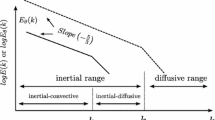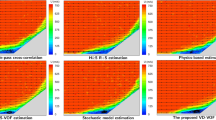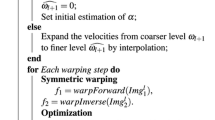Abstract
We propose a new formulation of optical flow in the case of passive scalar or solid particles spreading in turbulent flows. The flow equation is defined from the scalar transport equation and a decomposition of our physical quantities (velocity and concentration fields) into two contributions, large and small scales, to account for the lack of spatial resolution in processed images. A subgrid scale model is introduced to model the small scale contribution. Comparisons are made with existing optical flow methods and Particle Image Velocimetry on synthetic and real sequences. The improvement of the estimation of velocity field by the proposed formulation is discussed in the case of a scalar turbulent propagation.











Similar content being viewed by others
References
Adrian RJ (1991) Particle-imaging techniques for experimental fluid mechanics. Annu Rev Fluid Mech 23:261–304
Amini AA (1994) A scalar function formulation for optical flow: applications to X-ray imaging. In: Workshop on biomedical image analysis, pp 117–123
Ayrault M, Simoens S (1995) Turbulent concentration determination in gas flow using multiple ccd cameras. J Flow Visual Image Process 2(2):195–208
Bailloeul T, Prinet V, Serra B, Marthon P (2005) Spatio-temporal prior shape constraint for level set segmentation. In: Energy minimization methods in computer vision and pattern recognition (EMMCVPR), LNCS 3757. Springer, Berlin, pp 503–519
Baker S, Roth S, Scharstein D, Black MJ, Lewis JP, Szeliski R (2007) A database and ation methodology for optical flow. In: International conference on computer vision (ICCV), pp 1–8
Barron JL, Fleet DJ, Beauchemin S (1994) Performance of optical flow techniques. Int J Comput Vis 12(1):43–77
Batchelor GK (1967) An introduction to fluid dynamics. Cambridge University Press, Cambridge
Bereziat D, Herlin I, Younes L (1999) Motion estimation using a volume conservation hypothesis. In: International conference on acoustic, speech and signal processing (ICASSP), pp 3385–3388 (Phoenix)
Black M, Anandan P (1996) The robust estimation of multiple motions: parametric and piecewise-smooth flow-fields. Comput Vis Image Understand 63(1):75–104
Burt P, Adelson E (1983) The Laplacian pyramid as a compact image code. Trans Commun 31(4):532–540
Carlier J, Wieneke B (2005) Report on production and diffusion of fluid mechanics images and data. Technical Report, Fluid Project deliverable 1.2
Cassisa C, Prinet V, Shao L, Simoens S, Liu C (2008) Optical flow robust estimation in a hybrid multi-resolution MRF framework. In: International conference on acoustics, speech and signal processing (ICASSP), pp 793–796
Cassisa C, Simoens S, Prinet V (2009) Two-frame optical flow formulation in an unwrapping multi-resolution scheme. In: 14th Iberoamerican conference on pattern recognition (CIARP), LNCS 5856. Springer, Berlin, pp 790–797
Cassisa C, Simoens S, Prinet V (2010) Local Vs global energy minimization methods: application to stereo matching. In: International conference on progress in informatics and computing (PIC)
Chollet JP, Lesieur M (1981) Parameterisation for small scales of three dimensional isotropic turbulence using spectral closure. J Atmos Sci 38:2747–2757
Comte-Bellot G, Corrsin S (1966) The use of a contraction to improve the isotropy of grid generated turbulence. J Fluid Mech 25:657–682
Corpetti T, Heitz D, Arroyo G, Menin E, Santa-Cruz A (2006) Fluid experimental flow estimation based on an optical-flow scheme. Exp Fluids 40(1):80–97
Cui G, Xu C, Fang L, Shao L, Zhang Z (2007) A new subgrid eddy-viscosity model for large-eddy simulation of anisotropic turbulence. J Fluid Mech 582:377–397
Deradorff JW (1970) A numerical study of three-dimensional turbulent channel flow at large Reynolds numbers. J Fluid Mech 41:453–480
Garbe CS, Spies H, Jähne B (2003) Estimation of surface flow and net heat flux from infrared image sequences. J Math Imaging Vis 19:159–174
Haussecker HW, Fleet DJ (2000) Computing optical flow with physical models of brightness variation. In: Conference on computer vision and pattern recognition, vol 2, pp 760–767
Heas P, Memin E, Papadakis N, Szantai A (2007) Layered estimation of atmospheric mesoscale dynamics from satellite imagery. Geosci Remote Sens IEEE Trans 45(12):4087–4104
Heitz D, Heas P, Memin E, Carlier J (2008) Dynamic consistent correlation-variational approach for robust optical flow estimation. Exp Fluids 45(4):595–608
Heitz D, Memin E, Schnrr C (2010) Variational fluid flow measurements from image sequences: synopsis and perspectives. Exp Fluids 48(3):369–393
Horn B, Schunck B (1981) Determining optical flow. Artif Intell 17(1–3):185–203
Kolmogorov AN (1941) The local structure of turbulence in incompressible viscous fluid for very large Reynolds numbers. USSR Acad Sci 30:299–303
Kolmogorov V, Zabih R (2004) What energy ffunctions can be minimized via graph cuts? IEEE Trans Pattern Anal Mach Intell (PAMI) 26(2):147–159
Liu T, Shen L (2008) Fluid flow and optical flow. J Fluid Mech 614:253–291
Nomura A, Miike H, Yokoyama E (1995) Detecting motion and diffusion from a dynamic image sequence (in Japanese). Trans IEEE Jpn 115(C):403–409
Papadakis N, Mémin E (2008) Variational assimilation of fluid motion from image sequences. SIAM J Imaging Sci 4:343–363
Papenberg N, Bruhn A, Brox T, Weickert J (2003) Numerical justification for multi-resolution optical flow computation. In: International workshop on computer vision and image analysis (IWCVIA), vol 26, pp 7–12
Papenberg N, Bruhn A, Brox T, Didas S, Weickert J (2006) Highly accurate optic flow computation with theoretically justified warping. Int J Comput Vis 67(2):141–158
Ribault C, Sakar S, Stanley S (2001) Large eddy simulation of evolution of a passive scalar in plane jet. Am Inst Aeronaut Astronaut J 39:1509–1516
Ruhnau P, Schnorr C (2007) Optical stokes flow estimation: an imaging-based control approach. Exp Fluids 42(1):61–78
Shao L, Bertoglio JP, Michard M (1990) Large Eddy simulation of the interaction between two distinct turbulent velocity scales. In: Advances in turbulence, 3 edn. Springer, Berlin, pp 101–112
Shao L, Michard M, Bertoglio JP (1991) Effect of a solid body rotation on the turbulent transport. Turbulent Shear Flow 8, Selected paper, Ed. Springer, Berlin, pp 369–381
Simoens S, Wallace J (2008) The flow across a street canyon of variable width—part 2: Scalar dispersion from a street level line source. Atmos Environ 42:2489–2503
Simoens S, Ayrault M, Wallace J (2007) The flow across a street canyon of variable width—part 1: Kinematic description. Atmos Environ 41:9002–9017
Smagorinsky J (1963) General circulation experiments with the primitive equations i. The basic experiment. Mon Weather Rev 91:99–164
Snyman JA (2004) Practical mathematical optimization: an introduction to basic optimization theory and classical and new gradient-based algorithms. Kluwer, Dordrect
Spalart P (1988) Direct simulation of a turbulent boundary layer up to Re θ = 1410. J Fluid Mech 187:61–98
Stan ZL (2001) Markov random field modelling in image analysis, 2nd edn. Springer, Berlin
Su L, Dahm W (1996) Scalar imaging velocimetry measurements of the velocity gradient tensor field in turbulent flows. i. Assessment of errors. Phys Fluids 8:1869–1882
Su L, Dahm W (1996) Scalar imaging velocimetry measurements of the velocity gradient tensor field in turbulent flows. ii. Experimental results. Phys Fluids 8:1883–1906
Suter D (1994) Motion estimation and vector splines. In: International conference on computer vision and pattern recognition (CVPR), pp 939–942
Szeliski R, Zabih R, Scharstein D, Veskler O, Kolmogorov V, Agarwala A, Tappen M, Rother C (2008) A comparative study of energy minimization methods for Markov random fields with smoothness-based priors. IEEE Trans Pattern Anal Mach Intell (PAMI) 30(6):1068–1080
Vincont J, Simoens S, Ayrault M, Wallace J (2000) Passive scalar dispersion in a turbulent boundary layer from a line source at the wall and downstream of an obstacle. J Fluid Mech 424:127–167
Weickert J, Schnorr C (2001) Variational optic flow computation with a spatio-temporal smoothness constraint. J Math Imaging Vis 14(3):245–255
Winkler G (1995) Image analysis, random fields, and dynamic Monte Carlo methods: a mathematical introduction. Springer, Berlin
Zhou L, Kambhamettu C, Goldgof DB (2000) Fluid structure and motion analysis from multi-spectrum 2d cloud image sequences. In: International conference on computer vision and pattern recognition (CVPR) 2:744–751
Acknowledgments
The authors wish to thank the team of the European project Fluid in Rennes. Especially, Johan Carlier for giving us the DNS scalar synthetic sequence and Thomas Corpetti for providing us the estimated fields of his OF algorithm for this DNS sequence. This work is partially supported by the 863 program of the Chinese Ministry of Science and Technology and by Tandem - Erasmus Mundus Program.
Author information
Authors and Affiliations
Corresponding author
Rights and permissions
About this article
Cite this article
Cassisa, C., Simoens, S., Prinet, V. et al. Subgrid scale formulation of optical flow for the study of turbulent flow. Exp Fluids 51, 1739–1754 (2011). https://doi.org/10.1007/s00348-011-1180-5
Received:
Revised:
Accepted:
Published:
Issue Date:
DOI: https://doi.org/10.1007/s00348-011-1180-5




